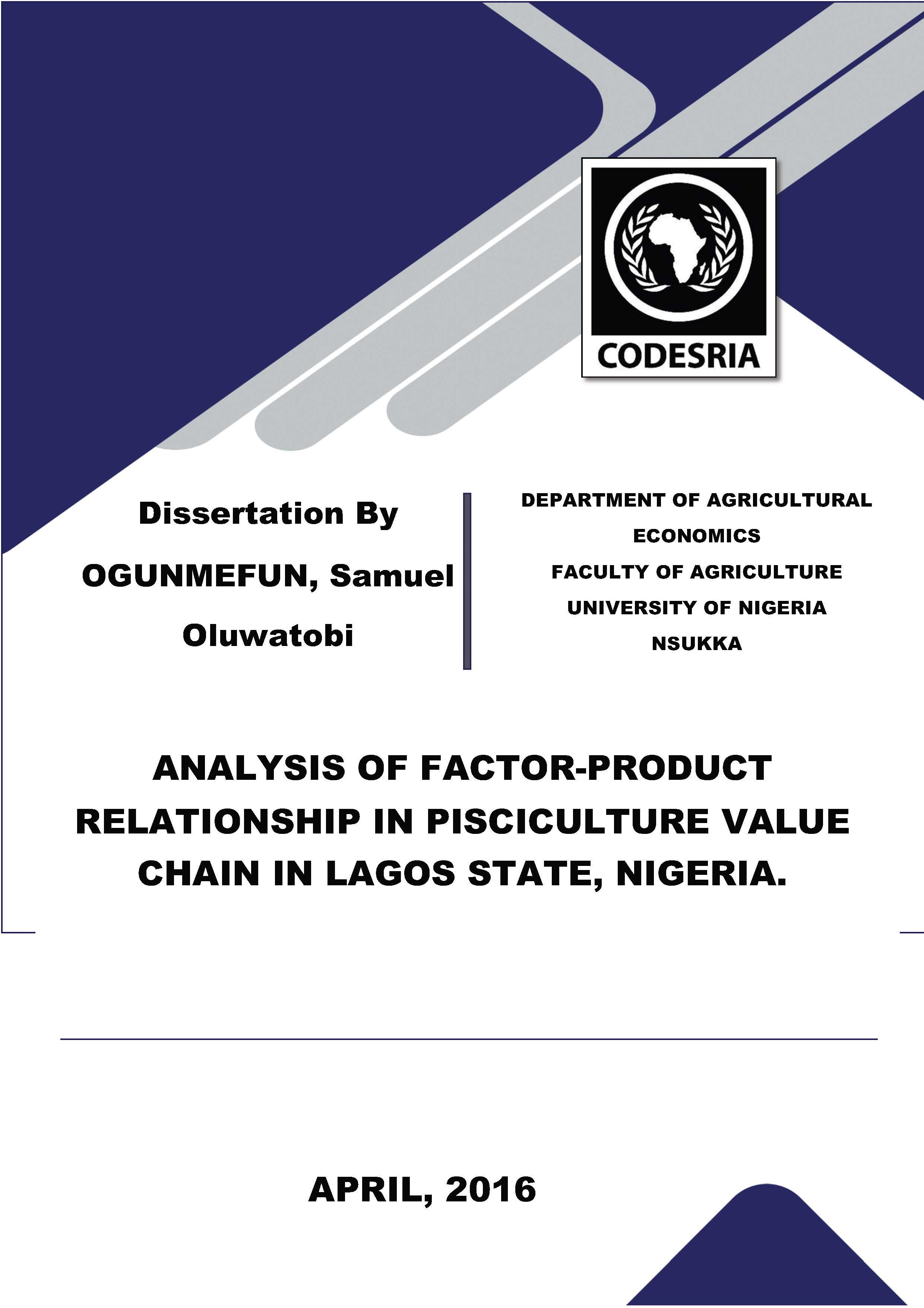ANALYSIS OF FACTOR-PRODUCT RELATIONSHIP IN PISCICULTURE VALUE CHAIN IN LAGOS STATE, NIGERIA
Mots-clés :
fish culture, factor-product relationship, value chain analysis, Nigeria, LagosSynopsis
The broad objective of the study was to analyze factor-product relationship in pisciculture value chain in Lagos state, Nigeria. The specific objectives were to: (i) determine the socio-economic characteristics of the pisciculture farmers and examine influence on their output, (ii) identify the value chain steps in pisciculture enterprise, (iii) determine the factor-product relationship and estimate the technical efficiency in the value chain, (iv) estimate the costs and returns of pisciculture value chain and (v) identify the various constraints facing the pisciculture value chain. The study adopted the survey design. It utilized mainly primary data. A structured close-ended questionnaire was used to collect information from the 120 fish farmers in the area. Data generated were analyzed using the stochastic frontier analysis (SFA), budgetary analysis, rate of return; test of difference in mean and value chain analysis. Average output of fish per production cycle was 14,000kg, while an average farm size (land) was 1.97ha per farmer. Average scores for farming experience, household size and years of schooling were 11.7years, five persons and 14.4 years respectively. The farmers were young as indicated by mean age of 43years. The result showed that all farmers (100%) culture fingerlings, juveniles and market size fishes while only few carryout hatching of eggs (40%) and culture fries (50%) in pisciculture enterprise in the state. Mean scores for pond size (????????????=2.22m2) and feed (????????????=3.12N/ha) were also recorded. Six factors namely, farm size, labour, feed, fertilizer, stocking capacity and depreciation value with coefficients of 0.02, 0.28, 0.03, 0.04, 0.40 and 0.20 respectively exerted significant (p<0.05) effects on the output of fish. All the production variables analyzed were positive except farm size and feed. The major determinants of efficiency were identified to be farm size and stocking capacity. The farmers are fairly efficient technically, with a mean efficiency estimate of 0.88 (????????????=88%). An average profit of N5,371,497.753 was recorded per farmer per farming cycle with a 2.2 return on investment (ROI) for farmers without value chain; while an average profit of N6,734,290.39 and a 2.0 return on investment was indicated on the other hand for farmers with value chain; indicating an average difference in margin of N1,362,792.64 between these farmers per production cycle. Also, the study revealed that hatching of eggs which only takes place in one week generates an average profit of N71,457.18 to the farmers while culturing of fries only generates on the average after two weeks a net profit of N16,928.36, while on the other hand, culturing of fingerlings which take up to four weeks generates an average profit of N467,856.72. Post-fingerlings culturing rakes in an average profit of N187,856.72 after four weeks while juvenile culture gives an average profit of N2,987,856.72 after four weeks while raising fish to market size which takes another four weeks produces on the average a profit of N1,542,223.29. It was therefore deduced that the highest profit in the chain of pisciculture enterprise remains culturing of juvenile and raising to market size respectively. Constraints to pisciculture enterprise in the state were high feed cost (????????????>3.8), lack of credit (????????????>3.6), high cost of inputs (????????????>3.4) and poor technical know-how (????????????>3.4). Value chain exerted no significant effect on the efficiency level (88%) of fish farmers in the area. This study therefore recommended that an aggressive awareness on the importance and training of pond fish farmers on value chain inculcation in their enterprise. Furthermore, provision of market and market information where these fish and fish products could be sold at profitable prices will enhance and ensure that farmers are not only food secured but also financially comfortable.
Téléchargements
Références
Abila, R. and Jansen, E.G. (1997). From Local To Global Markets: The Fish Exporting And Fishmeal Industries of Lake Victoria: Structure, Strategies And Socio-Economic Impacts In Kenya, IUCN, Nairobi.
ABT Associates (2005). Evolution of Food Marketing Systems: Implications for Producers in Developing Countries, Abt Associates Inc.
ACDI-VOCA (2006). The Value Chain Approach; Strengthening Value Chains To Promote Economic Opportunities: World Report Fall. ACDI-VOCA.
Achionye-Nzeh, G. C. Ogidiolu and Salami, S. (2002). Growth response of juveniles of Clarias anguillaris to diet formulated with Cirina forda larvae in the laboratory. Nig. J. Of pure and Applied science. 17: 1253-1256.
Adekoya B.B, Miller JW (2004). Fish Cage Culture Potential in Nigeria-An Overview. National Cultures. Agric. Focus, 15: 10
Adeogun O. A, Ogunbadejo H. K, Ayinla OA, Oresegun A, Oguntade OR, Tanko A, Williams SB (2007). Urban Aquaculture: Producer Perceptions and Practices in Lagos State, Nigeria. Middle-East J. Sci.Res. 2 (1): 21-27
Adewuyi S. A., Phillip, B. B., Ayinde, I. A., and Akerele, D. (2010), Analysis of Profitability of Fish Farming in Ogun State, Nigeria. Kamla-Raj 2010 J Hum Ecol, 31(3): 179-184.
Adikwu, I.A. and A.Y.Yusuf, (1997). Use Of Waste Of Agro And Agro-Allied Activities In The Nutrition Of African Catfish - Clarias gariepinus. Proceedings of the National Society of Nigeria. May 6-8. pp 65 – 68.
Adinya I. B, Ikpi GU (2008). Production Efficiency in Catfish (Clarias gariepinus) Burchell, 1822 in Cross River State, Nigeria. Continental J. Fisheries and Aquatic Sci. 2:13-22
Adinya I. B, Offem BO, Ikpi GU (2011). Application of a Stochastic Frontier Production Function for Measurement and Comparison of Technical Efficiency of Mandarin Fish and Clown Fish Production in Lowlands Reservoirs, Ponds and Dams of Cross River State, Nigeria. The J.Animal and Plant Sci., 21(3): 595 600
Agbebi, F.O. and Fagbenro, O.A. (2006): Tilapia culture and Risk Management in Nigeria. American Tilapia Association. In Collaboration with International Symposium on Tilapia in Aquaculture.
Agriculture and Agri-Food Canada (2008). Seafood Value Chain Round Table, Agriculture and Agri-Food Canada.
Agrodok. (2008). Small-scale freshwater fish farming. Agrodok Pub.#15. By Eira Carbollo, A. van Eer, T. van Schie and A. Hilbrands. Pub. Agromisa Foundation and CTA, Wageningen. 84 p.
Ahmed, N., (2007). Value chain analysis for Hilsa marketing in coastal Bangladesh, Aquaculture News, University of Sterling, Sterling, UK, January 2007, pp. 14–19.






